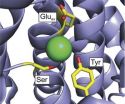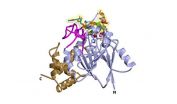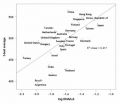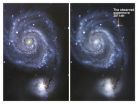(Press-News.org) NEW YORK (September 11, 2014) – A new study led by the Wildlife Conservation Society reveals that in India's human dominated agricultural landscapes, where leopards prowl at night, it's not livestock that's primarily on the menu – it is man's best friend.
The study, which looked at scat samples for leopards in India's Ahmednagar's district in Maharashtra, found that 87 percent of their diet was made up of domestic animals. Domestic dog dominated as the most common prey item at 39 percent and domestic cats were second at 15 percent.
Seventeen percent of the leopard's diet consisted of assorted wild animals including rodents, monkeys, and mongoose, and birds.
Livestock, despite being more abundant, made up a relatively small portion of the leopard's diet. Domestic goats, for example, are seven times more common than dogs in this landscape, yet only make up 11 percent of leopard's prey. The author's say this is because goats are less accessible and often brought into pens at night, while dogs are largely allowed to wander freely. Cows, sheep, and pigs were also eaten, but collectively made up less than 20 percent of leopard's food. Most domestic cattle in this region are too large to be preyed on by leopards.
The author's of the study say that the selection of domestic dogs as prey means that the economic impact of predation by leopards on valuable livestock is lower than expected. Thus, human-leopard "conflict" is more likely to be related to people's fears of leopards foraging in the proximity of their houses and the sentimental value of dogs as pets.
Study co-author Ullas Karanth, WCS Director for Science-Asia, said: "During the past two-to-three decades, legal regulation of leopard hunting, increased conservation awareness, and the rising numbers of feral dogs as prey have all led to an increase in leopard numbers outside of nature reserves in agricultural landscapes. While this is good news for conservation and a tribute to the social tolerance of Indian people, it also poses major challenges of managing conflict that occasionally breaks out. Only sound science can help us face this challenge."
INFORMATION:
The study appears in the Sept. 11th issue of the journal Oryx. Authors include: Vidya Athreya and Ullas Karanth of the Wildlife Conservation Society, Morten Odden of Hedmark University , John D.C. Linnell of the Norwegian Institute for Nature Research, and Jagdish Krishnaswamy of the Ashoka Trust for Research in Ecology and the Environment.
Wildlife Conservation Society (WCS)
MISSION: WCS saves wildlife and wild places worldwide through science, conservation action, education, and inspiring people to value nature. VISION: WCS envisions a world where wildlife thrives in healthy lands and seas, valued by societies that embrace and benefit from the diversity and integrity of life on earth. To achieve our mission, WCS, based at the Bronx Zoo, harnesses the power of its Global Conservation Program in more than 60 nations and in all the world's oceans and its five wildlife parks in New York City, visited by 4 million people annually. WCS combines its expertise in the field, zoos, and aquarium to achieve its conservation mission. Visit: http://www.wcs.org;; http://www.youtube.com/user/WCSMedia Follow: @thewcs.
Study: Cat bites dog
In India's human dominated landscapes, the number 1 prey for leopards is man's best friend
2014-09-11
ELSE PRESS RELEASES FROM THIS DATE:
Is the pattern of brain folding a 'fingerprint' for schizophrenia?
2014-09-11
Philadelphia, PA, September 11, 2014 – Anyone who has seen pictures or models of the human brain is aware that the outside layer, or cortex, of the brain is folded in an intricate pattern of "hills", called gyri, and "valleys", called sulci.
It turns out that the patterns of cortical folding are largely consistent across healthy humans, broadly speaking. However, disturbances in cortical folding patterns suggest deeper disturbances in brain structure and function.
A new study published in the current issue of Biological Psychiatry suggests that schizophrenia is associated ...
How bacteria battle fluoride
2014-09-11
He's not a dentist, but Christopher Miller is focused on fluoride. Two studies from his Brandeis University lab provide new insights into the mechanisms that allow bacteria to resist fluoride toxicity, information that could eventually help inform new strategies for treating harmful bacterial diseases. The studies appear in The Journal of General Physiology (JGP).
Although most animal cells are protected from direct exposure to fluoride, this toxic element is a serious threat to single-celled organisms like bacteria and yeast. As a result, their plasma membranes carry ...
Structure of enzyme seen as target for ALS drugs
2014-09-11
VIDEO:
In this movie, the Dbr1 enzyme rotates 360 degrees. Partially inhibiting Dbr1 could represent a new way to treat most cases of amyotrophic lateral sclerosis (ALS), according to a new...
Click here for more information.
SAN ANTONIO, Texas, U.S.A. (Sept. 10, 2014) — Investigators from the School of Medicine at The University of Texas Health Science Center at San Antonio have determined the first high-resolution structure of an enzyme that, if partially inhibited, could represent ...
Hold the mayo
2014-09-11
You are what you eat, the saying goes, and now a study conducted by researchers at UC Santa Barbara and the University of Pittsburgh suggests that the oft-repeated adage applies not just to physical health but to brain power as well.
In a paper published in the early online edition of the journal Prostaglandins, Leukotrienes and Essential Fatty Acids, the researchers compared the fatty acid profiles of breast milk from women in over two dozen countries with how well children from those same countries performed on academic tests.
Their findings show that the amount of ...
Researchers create world's largest DNA origami
2014-09-11
Researchers from North Carolina State University, Duke University and the University of Copenhagen have created the world's largest DNA origami, which are nanoscale constructions with applications ranging from biomedical research to nanoelectronics.
"These origami can be customized for use in everything from studying cell behavior to creating templates for the nanofabrication of electronic components," says Dr. Thom LaBean, an associate professor of materials science and engineering at NC State and senior author of a paper describing the work.
DNA origami are self-assembling ...
New superfoods could help key protein keep bodies healthy
2014-09-11
A new generation of new superfoods that tackle heart disease and diabetes could be developed following research into a protein that helps keep cells in our bodies healthy.
Researchers at the University of Warwick found that the protein, called Nrf2, continually moves in and out of the nuclei of human cells to sense the cell's health and vitality.
When Nrf2 is exposed to threats to the cell's health it oscillates faster and activates an increase in the cell's defence mechanism, including raising the levels of antioxidant.
The researchers, from the University's Warwick ...
Childhood mentors have positive impact on career success
2014-09-11
New research from North Carolina State University finds that young people who have had mentors are more likely to find work early in their careers that gives them more responsibility and autonomy – ultimately putting them on a path to more financially and personally rewarding careers.
"We wanted to look at the long-term impacts on mentees in naturally occurring mentorship relationships, rather than participants in formal mentorship programs," says Dr. Steve McDonald, an associate professor of sociology at NC State and lead author of a paper on the work. "And we found ...
Graphene paints a corrosion-free future
2014-09-11
The surface of graphene, a one atom thick sheet of carbon, can be randomly decorated with oxygen to create graphene oxide; a form of graphene that could have a significant impact on the chemical, pharmaceutical and electronic industries. Applied as paint, it could provide an ultra-strong, non-corrosive coating for a wide range of industrial applications.
Graphene oxide solutions can be used to paint various surfaces ranging from glass to metals to even conventional bricks. After a simple chemical treatment, the resulting coatings behave like graphite in terms of chemical ...
Lurking bright blue star caught!
2014-09-11
This release is available in Japanese.
A team led by Gastón Folatelli at the Kavli IPMU, the University of Tokyo, has found evidence of a hot binary companion star to a yellow supergiant star, which had become a bright supernova. The existence of the companion star had been predicted by the same team on the basis of numerical calculations. This finding provides the last link in a chain of observations that have so far supported the team's theoretical picture for this supernova. The results are published in the Astrophysical Journal Letters and have wide implications for ...
High levels of physical activity linked to better academic performance in boys
2014-09-11
A recent Finnish study shows that higher levels of physical activity are related to better academic achievement during the first three school years particularly in boys. The study published in PLOS ONE was conducted in collaboration with the Physical Activity and Nutrition in Children (PANIC) Study conducted at the University of Eastern Finland and the First Steps Study at the University of Jyväskylä.
The study investigated the relationships of different types of physical activity and sedentary behavior assessed in the first grade to reading and arithmetic skills in grades ...
LAST 30 PRESS RELEASES:
Numbers in our sights affect how we perceive space
SIMJ announces global collaborative book project in commemoration of its 75th anniversary
Air pollution exposure and birth weight
Obstructive sleep apnea risk and mental health conditions among older adults
How talking slows eye movements behind the wheel
The Ceramic Society of Japan’s Oxoate Ceramics Research Association launches new international book project
Heart-brain connection: international study reveals the role of the vagus nerve in keeping the heart young
Researchers identify Rb1 as a predictive biomarker for a new therapeutic strategy in some breast cancers
Survey reveals ethical gaps slowing AI adoption in pediatric surgery
Stimulant ADHD medications work differently than thought
AI overestimates how smart people are, according to HSE economists
HSE researchers create genome-wide map of quadruplexes
Scientists boost cell "powerhouses" to burn more calories
Automatic label checking: The missing step in making reliable medical AI
Low daily alcohol intake linked to 50% heightened mouth cancer risk in India
American Meteorological Society announces Rick Spinrad as 2026 President-Elect
Biomass-based carbon capture spotlighted in newly released global climate webinar recording
Illuminating invisible nano pollutants: advanced bioimaging tracks the full journey of emerging nanoscale contaminants in living systems
How does age affect recovery from spinal cord injury?
Novel AI tool offers prognosis for patients with head and neck cancer
Fathers’ microplastic exposure tied to their children’s metabolic problems
Research validates laboratory model for studying high-grade serous ovarian cancer
SIR 2026 delivers transformative breakthroughs in minimally invasive medicine to improve patient care
Stem Cell Reports most downloaded papers of 2025 highlight the breadth and impact of stem cell research
Oxford-led study estimates NHS spends around 3% of its primary and secondary care budget on the health impacts of heat and cold in England
A researcher’s long quest leads to a smart composite breakthrough
Urban wild bees act as “microbial sensors” of city health.
New study finds where you live affects recovery after a hip fracture
Forecasting the impact of fully automated vehicle adoption on US road traffic injuries
Alcohol-related hospitalizations from 2016 to 2022
[Press-News.org] Study: Cat bites dogIn India's human dominated landscapes, the number 1 prey for leopards is man's best friend







